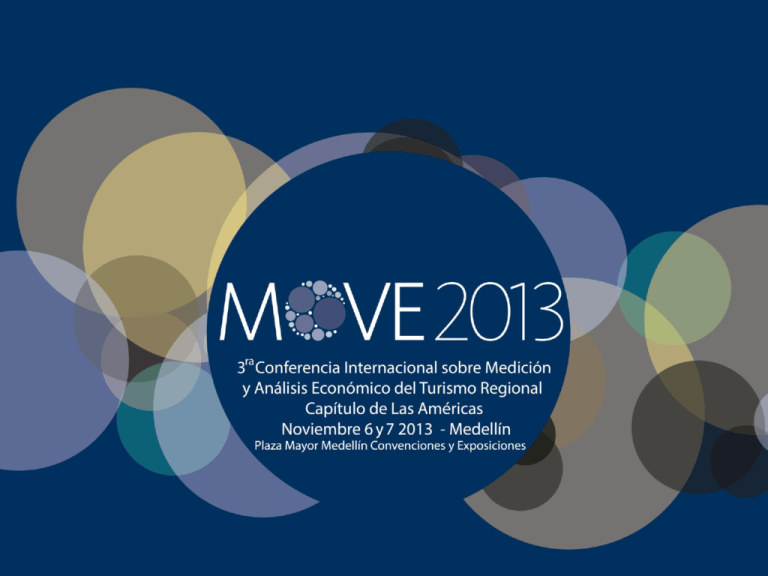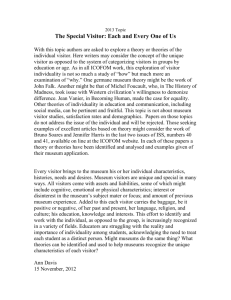Presentación de PowerPoint
advertisement

Real time experience tracking and human behavior tracking: Macro and micro approaches to measuring tourist behavior Adee Athiyaman Professor of Marketing Western Illinois University Frank Go Professor of Tourism Marketing Erasmus University Focus of Research: How could we assess tourists’ behavior at the primary and secondary levels using digital devices such as cellphones. • • Primary = Product Category Secondary = Brand Theory: SOR Needs or motives make one to pay attention to relevant information, and learn, attain or use a concept (for example, learn about a new product) In marketing terms: Need Arousal Consideration Set Touch Points Evaluation Choice Consideration Set and the Funnel Model: 1. Consideration set varies by context (for example, duration of visit); 2. Our research suggests that it is one attraction, on average, per weekend trip. 3. Contrary to the funnel model, the number of attractions under consideration tend to expand during the actual visit. For one tourist, it was a hand-painted sign in a hotel lobby that welcomed visitors to an art show that triggered the expansion. For another it was the recommendation of a filling station attendant that made him visit a “muscle-car” museum. Touch Points and Media Media Paid Owned Earned Sold Hijacked Definition The DMO pays to promote its products Examples TV commercials, print ads, search-engine marketing. DMO’s own channel Web sites, Facebook for advertising pages Third party create Consumer ratings, media or share DMO’s discussions on forums media to discuss such as TripAdvisor. about attractions, etc. DMO invites other Selling ad-space on businesses to place DMO’s web site. their content on its owned media DMO’s ad campaign is Opposition creates taken hostage by and distribute those who oppose it negative ads about the DMO The point is that DMOs need to know tourists’ touch points so that they can be influenced, where possible. Method: Before the start of her tours, the tourist will complete an online questionnaire about her awareness, attitudes, and intentions to visit one or more of the attractions; Then, during her travels, she would text a fourcharacter message whenever she encounters or come across stimuli relevant to the attractions; At the end of her travels, she would complete an exit survey which would mimic the first online survey so that changes in her awareness, attitudes, and behavior toward attractions could be gauged. Validation: Respondents were visitors to a toll-way oasis outside of Chicago (route I-88 toll-way) during the start of a weekend (Friday between 5PM to 9PM). Intercept form screened the participants for appropriateness (for example, that they are visiting Chicago for the weekend, willing to SMS, etc.), and introduced them to the study. In all, 27 visitors agreed to be part of the study. They were requested to self-administer an online survey. Survey Questions What tourist attractions are you thinking of visiting during the weekend? Questions about benefit beliefs: “Do you believe that the admission fee to visit the Field Museum is not at all expensive, somewhat expensive, moderately expensive, or very expensive”. Limited to six tourist attractions: Field Museum, Hancock observatory, Lincoln Park Zoo, Millennium Park, Navy Pier, and Sears Tower. Behavioral intention: “If you were going to visit cultural attractions, how likely it is that you will visit the Field Museum”. Pre-visit, online-survey results: What tourist attractions are you thinking of visiting during the weekend? Attraction Shedd Aquarium % Intending Attraction to Visit (n = 27) 22 Museum of Science and Industry 20 John Hancock Center 17 Sears Tower 16 Other Lincoln Park Zoo Navy Pier Millennium Park Field Museum 9 of Natural History % Intending to Visit (n = 27) 7 4 3 2 Fifteen respondents (56%) remained engaged with the program and sent at least one SMS. The most frequently cited touch point was friends’ recommendations. It is the earned media that had the greatest influence on visitors’ attraction choice, followed by “owned” and “sold” media SMS Responses (n = 18) Attraction Touch Point Sears Tower Other travelers; DMO’s website Millennium Park Friends Field Museum Friends Attitude +5 Behavioral % of SMS Intention +5 50 +5 +5 +5 +4 33 17 Expansion of initial consideration set: initially, only one in 27 respondents stated her intention to visit Sears Tower. But during the visit, eight other respondents included it in their itinerary. Communications from other travelers were responsible for this change. The changes in pre-visit, post-visit scores for both attitudes and behavioral intentions for the attractions were attributed to impersonal, contextual factors such as crowd and noise. Pre-visit Survey and Post-visit Survey Average Attitude Scores Attraction Field Museum of Natural History John Hancock Center Lincoln Park Zoo Millennium Park Navy Pier Sears Tower Pre-Chicago-Visit Post-ChicagoScore (n = 27) Visit Score (n = 15) 4 2 6 3 2 3 8 7 5 7 8 4 Secondary Demand: Theory By monitoring visitor activities in an attraction, a context-aware, assistive system can help attraction personnel to initiate justin-time visitor assistance. This should enhance visitor satisfaction. A satisfied visitor is expected to not only repeat visit the attraction, but also engage in positive word-of-mouth and word-of-mouse. Method: The task is to predict nature of activities associated with a sequence of sensor events. For example, a visitor in a museum may look “lost” if she randomly walks around the exhibits halls. To find such activity states, we utilize naïve Bayes classifier. Validation The setting was a small regional museum in western Illinois. The museum curates one or two events in a year all concerned with historic artifacts of the region. In 2012 the museum attracted around 3000 visitors. The average visitor tends to be elderly (65+ years of age) who has passion for all things “classic”. The museum didn’t allow us to set up motion-detection sensors so we engaged in experiments and participant observations. 10 male graduate students were tracked in the museum by the first author who noted down where they went, stopped, as well as what they did Measures include: attraction power of an exhibit holding power: whether the student spent adequate time reading information about the exhibit sweep statistic: whether the student moved quickly or not through the museum space Typical flows: whether the student travelled the welltrodden path or not Experimental Observations Subject S1 S2 S3 S4 S5 S6 S7 S8 S9 S10 Attraction Power No Yes Yes Yes No Yes Yes No Yes No Holding Power Yes No No No Yes Yes Yes No No Yes Sweep Stat Yes No Yes No Yes Yes No Yes No Yes Typical Flow No No No No No No No Yes No Yes Category (Lost = No) Yes Yes No Yes Yes Yes No Yes Yes No To test the theory we observed three visitors to the museum, predicted their behavior using Naïve Bayes, and interviewed them individually to gauge the predictive accuracy of the model and their satisfaction with the visit. The results are shown below: Visitor Attraction Power Holding Power Sweep Stat Typical Flow V1 No No No Yes V2 V3 Yes Yes Yes Yes No Yes Yes Yes Prediction Accuracy of Prediction Lost Not accurate Not Lost Accurate Not Lost Accurate These are the takeaways for DMOs: Touch points are mostly driven by tourists: they “pull” information at all stages of the visit (pre-visit, during and post-visit). Concept attainment or learning about a tourism product often happens during a visit to a destination. This learning is mainly due to word-ofmouth from friends, family, and host-destination’s contacts. The methodology used to assess primary demand (real-time tourist tracker) is superior to conventional one-time, questionnaire-based, exit survey of visitors in providing insights about tourist behavior. Specifically, it minimizes reporting errors caused by memory lapses in revealing touch points. Visitor behavior tracking helps enhance visitor satisfaction.






